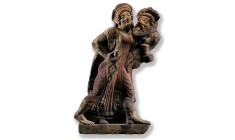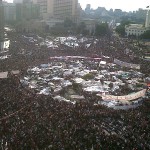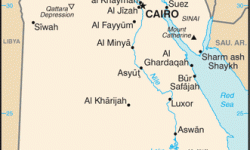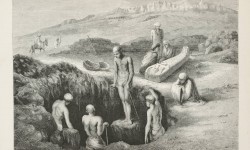Egyptian Museum in Cairo – Thefts and Recoveries in 2011
Author: Suzie Thomas
Last Modified: 21 Aug 2012
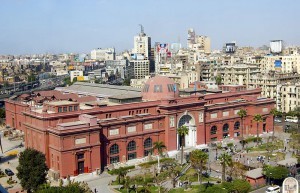
The Egyptian Museum in Cairo found itself in the centre of the 2011 Egyptian uprisings (the wider impact of which for Egypt is discussed in a separate entry), in part due to its location on Tahrir Square, upon which much of the protesting focussed (Anderson 2011). On 28 January 2011, despite apparent attempts to protect the museum and its contents (Butler 2011; El-Aref 2011a), looters and protesters entered the museum – possibly up to 1,000 individuals according reports (Sarant 2011) .
Although looters apparently raided the museum shop for jewellery, smashed display cases, (Sarant 2011) and ransacked the ticket office (ABC News 2011), it was at first unclear exactly what had been taken, with varying reports emerging suggesting different accounts of the damage caused and scale of loss of cultural objects. At the time of the break-in itself, nine individuals were reportedly arrested as they tried to make their way out of the museum via fire exits with the heads of two mummies that they had attempted to steal (but that had subsequently broken up into pieces) (ABC News 2011; Sarant 2011).
The threat to the cultural objects and monuments, not only at the Egyptian Museum itself but at other museums and at archaeological sites across Egypt, was quickly recognised by archaeologists and other observers both within Egypt and further afield. The Archaeological Institute of America (AIA) issued a statement shortly after the break-in which acknowledged that the political circumstances in Cairo in 2011 were different to those surrounding the looting of the Iraq National Museum in 2003, but that nonetheless Egyptian authorities needed to act to protect the country’s universally significant cultural heritage (Archaeological Institute of America 2011).
Other early reports emerged, primarily via the website of the then Minister for Antiquities Dr Zahi Hawass, that while there had been damage caused to up to seventy objects, apparently nothing had been stolen. A later statement from Hawass indicated that a number of objects had in fact been stolen (Taylor 2011a).
Recoveries and missing lists
In February 2011, a several objects were recovered after apparently being discarded near to the museum. For example, in mid-February a statue of the pharaoh Akhenaten was discovered amid garbage close to Tahrir Square (Taylor 2011b). Around the same time a number of other artefacts, including part of a broken, wooden sarcophagus were all found on the ground to the east of the museum (CNN Wire 2011; El-Aref 2011b). This led to suggestions that more objects would emerge through searching refuse and land in the proximity of the museum (Taylor 2011b).
In March 2011, a number of lists emerged of missing objects from the Egyptian Museum including a list from the University of Pennsylvania’s Penn Cultural Heritage Center which was issued on 1 March 2011 (Penn Cultural Heritage Center 2011), and a longer list from Egypt’s Supreme Council of Antiquities on 15 March 2011, featuring fifty-four objects (Supreme Council of Antiquities 2011). These were intended to raise awareness but also to encourage vigilance, for example at international borders (Penn Cultural Heritage Center 2011).
Further recoveries of objects were made in mid and late March 2011 (Rosenbaum 2011), and in May 2011 four statues were recovered during a ‘police action’, two of which were later confirmed to have come from the Egyptian Museum (Lorenzi 2011).
On 6 February 2012, just over a year after the events at the Egyptian Museum, the International Council of Museums (ICOM) launched the latest of its Red Lists series at the National Museum of Egyptian Civilisation, also in Cairo (ICOM 2012a), The Emergency Red List of Egyptian Cultural Objects at Risk (ICOM 2012b). This list, compiled with the assistance of the Supreme Council of Antiquities and the Egyptian Museum among others, includes types of objects from museums and sites in Egypt, rather than specific pieces. Anyone finding Egyptian antiquities and other cultural material that they suspect may have been looted or stolen from Egyptian sites or museums are urged to contact the Egyptian Museum in Cairo or the Supreme Council of Antiquities (ICOM 2012c). The Supreme Council of Antiquities, which had appointed a new Minister of Antiquities in December 2011 (El-Aref 2011c), in the same month launched a hotline for people to contact the Council, albeit intended for wider issues than just looting (El-Aref 2011d).
References
ABC News (2011), ‘Looters destroy mummies during Egypt protests’, ABC News [Online], (updated 30/01/2011) http://www.abc.net.au/news/2011-01-30/looters-destroy-mummies-during-egypt-protests/1922372, accessed 01/08/2012.
Anderson, Lisa (2011), ‘Demystifying the Arab Spring: Parsing the Differences Between Tunisia, Egypt and Libya’, Foreign Affairs, 90 (3), 1-7.
Archaeological Institute of America (2011), ‘Statement from the Archaeological Institute of America Concerning the Looting of Artifacts in Egypt’, http://www.archaeological.org/news/aianews/3934, accessed 01/08/2012.
Butler, Declan (2011), ‘Egyptians rally to defend cultural heritage’, Nature (updated 03/02/2011) http://www.nature.com/news/2011/110203/full/news.2011.72.html, accessed 08/05/2012.
CNN Wire (2011), ‘Some missing Egyptian relics found, antiquities chief says’, [Internet], (updated 14/02/2011) http://edition.cnn.com/2011/WORLD/meast/02/14/egypt.relics/, accessed 01/08/2012.
El-Aref, Nevine (2011a), ‘Help on hand for Egypt’s treasures’, Al-Ahram (updated 25/05/2011) http://weekly.ahram.org.eg/print/2011/1048/eg12.htm, accessed 14/05/2012.
— (2011b), ‘Looted Artifacts from Egyptian museum found’, Ahram Online (updated 14/02/2011) http://english.ahram.org.eg/News/5593.aspx, accessed 01/08/2012.
— (2011c), ‘New minister of antiquities, new strategy’, Ahram Online (updated 08/12/2011) <http://english.ahram.org.eg/News/28842.aspx, accessed 01/08/2012.
— (2011d), ‘Antiquities hotline to launch in Egypt on Monday’, Ahram Online (updated 18/12/2011) http://english.ahram.org.eg/News/29619.aspx, accessed 01/08/2012.
ICOM (2012a), ‘ICOM publishes a new Emergency Red List: the Emergency Red List of Egyptian Cultural Objects at Risk’, http://icom.museum/press-releases/press-release/article/icom-publishes-a-new-emergency-red-list-the-emergency-red-list-of-egyptian-cultural-objects-at-risk-1/print/1/, accessed 01/08/2012.
— (2012b), ‘Emergency Red List of Egyptian Cultural Objects at Risk’, in ICOM (ed.), (Paris: ICOM).
— (2012c), ‘Press Kit: Emergency Red List of Egyptian Cultural Objects at Risk’, in ICOM (ed.), ICOM (Paris: ICOM).
Lorenzi, Rossella (2011), ‘Egyptian artifacts recovered but from where?’, MSNBC (updated 05/05/2011) http://www.msnbc.msn.com/id/42916017/ns/technology_and_science-science/t/egypti, accessed 01/08/2012.
Penn Cultural Heritage Center (2011), ‘Antiquities Missing from Egypt’, (Philadelphia: University of Pennsylvania Museum).
Rosenbaum, Lee (2011), ‘Egyptian Museum Recoveries: Five more missing objects reclaimed’, http://www.artsjournal.com/culturegrrl/2011/03/five_more_objects_stolen_from.html, accessed 01/08/2012.
Sarant, Louise (2011), ‘Vandals ravage Egyptian Museum, break mummies’, http://www.egyptindependent.com/node/307570, accessed 01/08/2012.
Supreme Council of Antiquities (2011), ‘Final List of Objects Missing from tjhe Egyptian Museum 2011-03-15’, (Cairo: Supreme Council of Antiquities).
Taylor, Kate (2011a), ‘Egypt’s Antiquities Minister says Valuable Statue Found’, (updated 17/02/2011) http://artsbeat.blogs.nytimes.com/2011/02/17/egypts-antiquities-minister-says-valuable-statue-found/, accessed 01/08/2012.
— (2011b), ‘Stolen Egyptian Statue is found in Garbage’, (updated 17/02/2011) http://www.nytimes.com/2011/02/17/arts/design/17arts-STOLENEGYPTI_BRF.html, accessed 01/08/2012.
